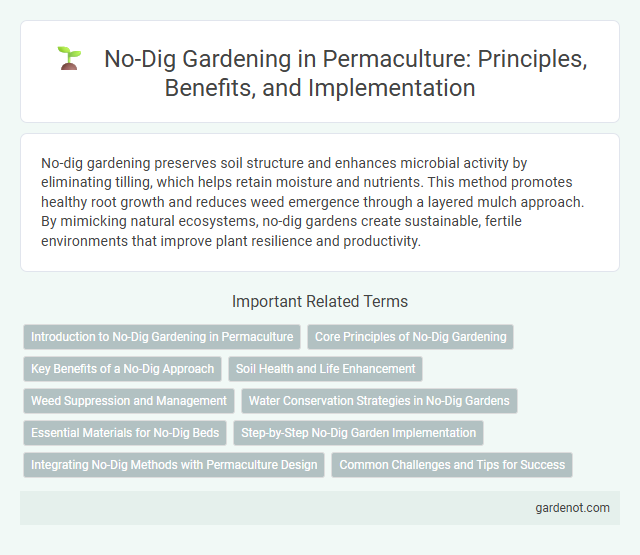No-dig gardening preserves soil structure and enhances microbial activity by eliminating tilling, which helps retain moisture and nutrients. This method promotes healthy root growth and reduces weed emergence through a layered mulch approach. By mimicking natural ecosystems, no-dig gardens create sustainable, fertile environments that improve plant resilience and productivity.
Introduction to No-Dig Gardening in Permaculture
No-dig gardening in permaculture promotes soil health by avoiding soil disturbance, preserving beneficial microorganisms and earthworms. This method enhances organic matter retention and reduces weed growth, leading to sustainable, nutrient-rich soil ecosystems. By layering mulch and compost on the surface, no-dig systems mimic natural forest floors, fostering resilient plant growth and biodiversity.
Core Principles of No-Dig Gardening
No-dig gardening centers on preserving soil structure by avoiding tillage, which maintains beneficial microbial communities and natural earthworm activity. Organic mulch layers suppress weeds, enhance moisture retention, and gradually enrich soil fertility through decomposition. Emphasizing minimal disturbance and natural soil building aligns with permaculture ethics of care for earth and sustainable resource use.
Key Benefits of a No-Dig Approach
A no-dig garden preserves soil structure and enhances microbial activity, leading to healthier plant growth and increased nutrient availability. This approach reduces weed emergence by maintaining intact soil layers and organic mulch, minimizing labor and the need for herbicides. Water retention improves significantly in no-dig systems, promoting drought resilience and reducing irrigation requirements.
Soil Health and Life Enhancement
No-dig gardening promotes soil health by minimizing disturbance, preserving soil structure, and maintaining beneficial microbial ecosystems. Mulching with organic matter enhances moisture retention and nutrient cycling, fostering diverse microbial life and earthworm activity essential for nutrient availability. This approach improves soil fertility naturally, creating a resilient environment that supports vigorous plant growth and long-term garden productivity.
Weed Suppression and Management
No-dig gardens effectively suppress weeds by maintaining a thick layer of organic mulch, which blocks sunlight and inhibits weed seed germination. This method preserves soil structure and microbial activity, reducing the need for physical weed removal and chemical herbicides. Consistent mulch application combined with strategic plant spacing further minimizes weed growth, promoting healthier crop development.
Water Conservation Strategies in No-Dig Gardens
No-dig gardens enhance water conservation by maintaining soil structure and organic mulch layers that reduce evaporation and improve moisture retention. Incorporating drip irrigation systems and rainwater harvesting techniques further optimizes water efficiency in these setups. Mulching with compost and straw creates a protective barrier, minimizing runoff and promoting deeper soil hydration essential for permaculture sustainability.
Essential Materials for No-Dig Beds
Essential materials for no-dig garden beds include layers of organic mulch such as straw, compost, and shredded leaves, which nourish the soil and suppress weeds. Cardboard or newspaper sheets serve as a biodegradable weed barrier that decomposes to improve soil structure. Consistent carbon-rich materials paired with nitrogen-rich compost create a balanced environment supporting soil microbes and plant growth without disturbing the soil layers.
Step-by-Step No-Dig Garden Implementation
Creating a no-dig garden begins with laying a thick layer of organic mulch or cardboard over the existing soil to suppress weeds and enrich the soil naturally. Next, add layers of compost and manure on top to build fertile soil without disturbing the ground structure. Regularly top up with mulch and organic matter to maintain soil health and encourage beneficial microbial activity for sustainable permaculture practices.
Integrating No-Dig Methods with Permaculture Design
Integrating no-dig methods with permaculture design enhances soil health by preserving microbial life and maintaining natural soil structure, which leads to improved water retention and nutrient cycling. Utilizing mulch layers, composting, and sheet mulching within permaculture beds reduces soil disturbance while promoting biodiversity and resilience. These techniques support sustainable food production by fostering regenerative ecosystems that require less maintenance and input over time.
Common Challenges and Tips for Success
No-dig gardens often face challenges such as weed control, soil compaction, and nutrient imbalances, which can hinder plant growth and yield. To overcome these issues, maintain a thick layer of organic mulch, incorporate diverse compost materials, and regularly monitor soil moisture and fertility levels. Successful no-dig gardening relies on fostering healthy soil microbiology and minimizing disturbance to enhance long-term productivity.
No-dig garden Infographic

 gardenot.com
gardenot.com